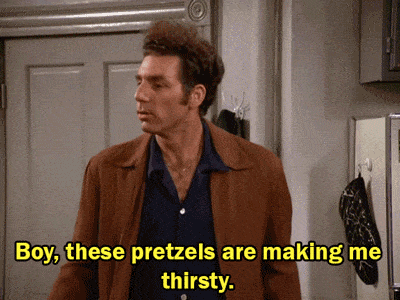Have you ever tried to research new content marketing techniques (or new products, services, recipes, lifestyle hacks, or home haircuts), but found yourself so disinterested in the content that your eyes glazed over and suddenly you were more focused on wondering whether a Care Bear or a My Little Pony would win in a dance-off and whether the two-legged anthropomorphized bear or the four-legged rainbow pony would have the advantage?
Yeah, me neither. But I have encountered content so dry it made me thirsty.

Apart from being inherently boring, the problem with dry, humorless content is that it’s also forgettable. To be successful in content marketing, when every brand is competing against thousands of others for audience attention, the content you serve your audience must be interesting, memorable, and (perhaps, most importantly) shareable.
Still not convinced?
Consider this: Would you rather spend your only free hour of the day reading boring stats and technical specs or laughing while learning about stats and technical specs?
Why Brands Use Humor Marketing
Sure, there are plenty of ways to make your brand’s content more interesting. You can use experience marketing, imagination marketing, or inspirational storytelling that moves your audience and helps them connect with your brand in a more serious way.
But humor marketing has a special kind of magic.
Firstly, who doesn’t like laughing? Smiling feels good because it actually triggers the release of endorphins. If you make your audience smile enough, they’ll start to associate those good vibes with your brand – just like Pavlov’s drooling dog and the dinner bell.
Humor also has the power to strengthen trust between the joke teller and the laugher, further increasing the connection between your audience and brand.
Comedy is also eye-catching. Funny content is the best way to grab your target audience’s attention – especially new audience members. If your initial message is funny enough to get a potential customer’s attention at the top of the funnel, your message will be strong enough to encourage them to continue interacting with your brand.
Fundamentally, humor marketing increases engagement. Whether you make a funny infographic, cleverly caption your Instagram photos, publish a hilarious Tweet, or write a side-splitting blog post, your audience will be more likely to read through your entire post, leave comments, share your content with their friends, and come back for more.
10 Types of Comedy to Use in Content Marketing
There are 10 types of comedy that are typically used in humor marketing. Here’s a quick look at what each entails:
1. Irony
No, Alanis, irony isn’t like rain on your wedding day – unless, you decided to get married in the Antarctic Dry Valleys where it hasn’t rained for millions of years specifically to avoid the rain and maybe to walk down an ice aisle with a penguin as a ring bearer – but irony is one of the best comedy writing techniques of all time.
The best news yet? There are three different ways to use it:
Situational Irony
Situational irony occurs when a situation turns out differently from what was expected (e.g. the Antarctic wedding). This is the type of irony that Alanis Morissette was trying to capture in her song “Ironic.”
Unfortunately, her lyrics failed to establish the unmet expectations, turning her situations and outcomes into lowly coincidences. You can use situational irony in your advertising to depict your brand as a hero, saving the day from unexpected and funny foibles.
Verbal or Socratic Irony
Don’t confuse verbal iron with sarcasm, which is typically caustic or mean-spirited in nature. Verbal irony occurs when the words a person utters by definition mean the opposite of what they intend to say. Verbal irony can be detected with tone or context.
For example, an ad for a deodorant company using verbal irony might have an image of rotting garbage with the text: “Don’t worry about your body odor! You smell delicious.”
Dramatic Irony
The third type of irony occurs when your audience is aware of information and your character is not. It is often used to increase the drama. In Romeo and Juliet, the audience knows Juliet is simply sleeping when Romeo believes her to be dead.
However, dramatic irony isn’t always such a drama queen. It’s a favorite in comedy, too! Recently, the hearing aid company, Eargo, made expert use of dramatic irony in a laugh-out-loud gem of a television spot that demonstrates just how well their hearing aids work (maybe too well!). Use your imagination, keep your characters in the dark, and wait for the laughs.
As it turns out, all types of irony can be incredibly humorous and useful in comedy marketing. Misunderstandings, clever words, and unexpected situations can all be funny when they’re deployed cleverly in your content marketing campaign.
2. Hyperbolic Humor
This type of humor uses exaggeration in a humorous way. In content marketing, hyperbole could show people the crazy-extravagant things they could do by saving money with your brand like ordering the biggest cheeseburger in the world with pool-noodle-sized fries.
With hyperbole, your content could be so funny, it could eat a horse. (Wait. What?)
3. Observational Humor
This type of comedy makes fun of everyday life or has the ability to see everyday life and its annoyances from an unexpected and funny perspective.
On the stand-up stage, it looks like Jerry Seinfeld delivering have-you-ever-noticed jokes about eating in restaurants or raising kids. In content marketing, it can be used to point out the customer’s pain point in a funny way before eventually showing them how your company will solve their problem.
4. Deadpan or Dry Humor
So blunt that it’s almost awkward, this form of humor is categorized by the content’s manner of delivery. Typically, dry humor is dished up with a deadpan facial expression, monotone speaking voice, and a matter-of-fact presentation that makes the ludicrous content that much funnier to the audience.

5. Topical Humor
This type of humor uses current events as comedic fodder. Think Saturday Night Live and Tonight Show monologues. For this type of humor to work, you need to be tuned in to the culture and current events and so does your audience. If you miss a beat or your audience isn’t aware of your joke’s context, your attempts at topical humor won’t be well received.
Also, since their relevance is fleeting, topical jokes aren’t the best choice for evergreen content; they have an expiration date that coincides with the rotation of the news cycle. You should avoid this use of humor in blog posts and articles that’ll live a long time on your website, but it’s perfect for pairing with popular hashtags on all your social media platforms.

6. Dark Humor
Dark humor usually has deep, dark, and scary themes with a sinister, underlying tone. Dark humor’s dismissive tone seeks to make light of disconcerting topics like mortality, illness, and despair.
Before you choose to use dark humor in your marketing, be sure it aligns with your brand voice and that this use of humor will jive with your audience. Studies have shown that individuals with higher intelligence tend to prefer dark humor, which can help you determine whether or not it’s an appropriate choice for your target market.
7. Blue Humor
Also called ribaldry or dirty jokes, blue humor doesn’t have a place in every brand’s content marketing strategy, but it can strike the perfect tone for others. If your audience is made up of adults, and you’re selling them fun, you can use funny, slightly inappropriate jokes in your advertising.
Be careful not to tread too far down the path of raunchiness. When you enter this territory, you make the assumption that your audience will appreciate blue humor and going too far risks offending them. Keep the jokes smart, relatively clean, and relevant to your brand.
8. Irreverent Humor
Irreverant humor is a type of dark humor. It doesn’t always deal with themes that are considered exceptionally dark, but it lets us laugh about topics that are normally held in high regard. Irreverant humor intentionally targets, disrespects, and makes fun of topics that are usually considered off-limits or sacred like serious global issues, politics, or religion.

If you choose to use irreverent humor in your marketing, be wary of the topics you put in your comedy crosshairs. Some of these topics like religion and politics are considered sacred for a reason – people take them seriously and hold their views close to their hearts.
9. Absurd Humor
Absurd humor isn’t afraid to get wacky, weird, and enter the realm of the surreal. Done right, absurd humor will make your brand appear brilliant and fun.
On the other hand, absurd humor executed poorly will earn way more raised eyebrows and eye rolls than laughs, and that’s never good for brand perception.
Take a good look at your brand personality before you decide whether or not absurdity will serve you.

10. Call-Back Jokes
Call-back comedy makes use of previous jokes by referring back to them at a later time. In a stand-up monologue, call-backs are usually delivered near the end of the comedian’s set (to a deafening roar of laughter). These jokes create rapport with an audience and give the audience the feeling of being in on an inside joke.
Call-back jokes are the perfect tool for making your existing customers feel super-close to your brand. Once you’ve established a relationship with some faithful followers on social media, you can use call-back jokes to improve customer retention, loyalty, and brand perception.
Just the Bad and the Ugly: The Types of Comedy to Avoid in Content Marketing
Telling jokes about some topics can cheapen them or come across as disrespectful. So, it’s best to be careful where you tread. To find the right topics, remember that comedic timing is everything; cracking the wrong joke at the wrong time can make you appear unprofessional, amateurish, and insensitive. It’s also a good idea not to be funny just for the sake of being funny. The jokes you choose to deliver should be related to your brand or should further your message in some way.
Good jokes should bring people together – not divide them. Mean, offensive, and insensitive jokes that poke fun at the wrong people, places, things, or ideas are not good. They’ll end up alienating members of your audience and could ultimately damage your brand.

Using the wrong kind of comedy in marketing should be avoided at all costs. A bad joke will simply be forgotten, but an offensive joke will isolate part of your audience and live on in the annals of internet shame forever. Sure, controversy has its benefits in the world of marketing. If you’re going to start a controversial buzz, however, it’s best to do so intentionally.
In spite of the potential risks, not all strange and dark forms of comedy are off-limits in marketing. With the right audience and execution, satire, irreverent comedy, the absurd, and even blue humor can find their place in your content marketing strategy.
When choosing the types of humor and the topics to use in your content marketing, put consideration for your audience, the social context, your brand, and your messaging first. The sort of humor that’ll land well on a luxury car brand’s audience, for example, will differ greatly from the comedy that will work well for a fast-food chain, and that will be vastly different from the jokes that work on a parenting blog.
Puns and Other Jokes for Content Marketing
Not mentioned above, another popular form of comedy requires wit, but it’s worth the effort. If you’re working with words (and in content marketing that’s often the case), then what better way to introduce humor than with wordplay? Puns, mixed metaphors, and malapropisms can be quite humorous.

Let’s talk about puns. You might be a magical wordsmith always at the ready with your witty wordplay, but puns should be carefully selected before you toss them into your content marketing campaigns.
For starters, puns can confuse search engines. If you use puns one in your company’s tagline, business name, product names, or other searchable terms, customers might have a tough time finding you within the haunted forest of the internet. Also, puns aren’t always funny. If yours falls flat or doesn’t quite make sense, then it’ll only serve to confuse your audience.
In the right context and with the right word choices, puns can be brilliant. Take this one, for example, from Dollar Shave Club (experts in content marketing humor): “Shave Time. Shave Money.” This pun works because it’s on-brand and the pun enhances – rather than obscures – the intended meaning.
As you can see, puns done right can work really well. Before going public with a pun, test it on a varied audience. Show it to coworkers, friends, and family members and carefully observe their response, paying close attention to their facial expressions in addition to verbal criticism.
Visual Comedy in Content Marketing
Pictures are worth a thousand jokes, and if eyeballs could laugh, they’d love this form of comedy. Visual comedy and visual gags make use of images, videos, comics, and unusual visual perspectives to generate humor. It’s perfect for content marketing. In visual comedy, there’s no need for words because the picture tells the joke. This gives your target audience the privilege of discovering the punchline on their own, which means they get to interact with and participate in your content.

This Coca-Cola ad has no need for words. Once you spot the penguin enjoying a stolen soda, the joke becomes self-evident.
To do visual comedy well, you don’t need an expert art department the size of Coca-Cola’s to create interesting and beautiful images. There’s plenty of material available for free. On social media, easily shareable memes, gifs, and caption this contests reign supreme. Just be sure you understand the social context associated with memes before you use them in your content marketing to avoid any embarrassing or reputation-damaging foibles.
With image captioning and memes, it’s clear that visual comedy doesn’t haven’t to be completely separate from verbal comedy. When paired well, visual and verbal jokes can be exceptionally clever. For example, this highlighter ad from Stabilo gets creative by mixing visual humor with wordplay. The ad demonstrates the staggering power (and fun) of using highlighters while also making fun of the nonsensical business-speak that’s usually employed in B2B marketing:

Inspire Your Funny Bone: Examples of Humor in Content Marketing
So far, you’ve learned a lot of rules and guidelines and textbook-like information on comedy writing techniques and how to be funny, but the truth is that humor and comedy in marketing (and in the rest of life) really aren’t something that can be made by following a bunch of rules.
While comedy writing techniques can help inspire your comedy marketing writing, they can’t teach you exactly how to make a relevant, on-brand, on-message, pertinent, good-spirited, joke that’s actually funny. To do this, it’s best to extend your humor marketing feelers into the world and take a look at how other funny content marketers are making their target audiences laugh.
Humor Marketing in Social Media
Look no further than the fast-food giant, Wendy’s, for a prime example of comedy in content marketing. Wendy’s witty Twitter persona has perfected the art of dry humor, banter, sarcasm, playfulness, and roasting something other than baked potatoes. In addition, they recognize that just being funny isn’t enough. They’re also incredibly responsive to problems and concerns as they arise.
For more social media laughs, check out Old Spice, Oreo, and BarkBox.
Humor In Serious Business
Just because you have a serious product or you provide a high-end brand doesn’t mean you can’t use comedy in marketing. Whether you’re promoting clean energy, luxury products, or working in insurance, you can still be funny. But – and this is a big but – you have to be smart about how you do it.
Geico initially revolutionized insurance advertising with their gecko and caveman jokes, making insurance something pleasant to think about. The life insurance company, DEADHAPPY, has taken a darker approach to the humor in their content marketing with a tagline that reads: “Make a death wish. Get life insurance.” Touting a goal to make 1,000,000 death wishes, DEADHAPPY markets to a youthful target audience. This young audience welcomes their off-color marketing in a funky-neon color palette with a positive reception.
Even BMW isn’t afraid to loosen up and expose their funny bone. In this humorous advertisement, the luxury car brand demonstrates one unexpected way their cars are better than Audi’s. Thanks to the ad’s playfulness, calling out Audi in the commercial, goes down way better than it would if BMW had taken a more serious approach to the ribbing.
Comedy Marketing in Business 2 Business
In B2B marketing, most companies are offering serious products at serious price points. This leads them to shy away from using humor in marketing for fear that they’ll undercut their reputation and make themselves seem like an illegitimate choice compared to competitors. This, however, is far from the truth.
B2B businesses are still marketing and selling to humans. Even if these humans are straight-laced CEOs, they still appreciate a laugh. Making your audience laugh at the top funnel of your content marketing campaign can cut through the marketing noise, make you appear authentic, and get you the initial attention you need to guide your potential customer down the funnel to a sale. Plus, B2B content is generally pretty dry on its own. No one wants to swallow a plateful of stats and tech specs. If you serve your company’s info with a glass of refreshing comedy, it’ll go down easier and you’ll make more sales.
Mailchimp is a great example of a B2B business that isn’t afraid to be funny and playful, while still demonstrating that they take their products and services seriously. On their YouTube Channel, for example, the content is all business, but the playful details (like a hedgehog in a cowboy hat) show that they know how to have a good time. As a potential customer, you might just get the idea that you’d like to sign up for their services and join them at the cute rodent rodeo.

Funny Marketing Campaign Examples
Every year, brands pay millions of dollars for the chance to make people laugh with ads during the Super Bowl. That is a testament to how well humorous marketing works.
All year round, companies look to make their brands and products stand out in people’s minds because they are funny – and some of them do it very well. Consider a few of the better humorous marketing campaigns in recent years.
Charmin
Few things make you cover your mouth and giggle, like bathroom humor. When your product lives in the bathroom, it makes sense to take advantage of that. One company that does that well is Charmin.
In 2014, Charmin launched a hashtag campaign that used the key phrase:
- #tweetfromtheseat
The goal was to encourage users to enter tweets while doing their business. This played on that dirty little secret most people know but few talk about. Mobile devices allow you to tweet from anywhere, including the toilet.
With this campaign, Charmin specifically targeted younger people, probably buying household products like TP for themselves for the first time. According to a Nielsen report from around that time, 40% of people between ages 18 and 24 are likely to be on social media in the bathroom.
The truth is many people probably do but don’t admit it. That’s what makes this campaign funny. You can admit you do it; nobody necessarily has to know it’s you.
What they did right:
- Played to a target group
- Used a channel that the group frequents
- Made the campaign interactive
They get bonus points for choosing humor that almost anyone would laugh at, potentially reaching beyond their target.
McDonald’s
Of course, McDonald’s has been using humor and creativity to sell burgers since the 1940s. One of their recent campaigns was designed to be funny and nostalgic.
In 2022, the iconic fast food chain introduced Happy Meals for adults. It came complete with a collectible toy. Who doesn’t love a free toy?
Along with the collectible, they upsized the meal to fit adult hunger. Instead of the standard burger or kid-sized chicken nuggets, adults got a Bic Mac or a 10-piece McNuggets, fries, and a drink.
The adult Happy Meals was part of a more extensive marketing campaign from McDonald’s that involved collaborating with other companies. They turned to Cactus Plant Flea Market Box for the eye-catching art on the packaging and collectible.
To say this campaign was a success is an understatement. Fifty percent of all the collectibles were gone in just four days.
What they did right:
- Made it not just humorous but nostalgic
- Collaborated with a name younger adults would likely recognize
- Used art and color to make the product stand out in ads
Kellogg’s Frosted Flakes
Kellogg’s also combined nostalgia and humor to create a successful marketing campaign. They took an iconic mascot of the cereal, Tony the Tiger, and brought him to life as a social media influencer or VTuber.
The marketing team partnered with Twitch’s Brand Partnership Studio to accomplish this impressive feat. His first appearance on the channel was at a live event in 2022. He challenged other gaming influencers to the popular Battle Royale game.
During the live stream, viewers could chat with one another and take part in polls. Twitch, owned by Amazon, has over 31 million daily visitors. In addition, the new version of Tony the Tiger has accounts on the most prominent social media platforms.
What they did right:
- They took something nostalgic to parents and made it appealing to their kids.
- They used tools that appeal to a younger audience: gaming and Twitch.
- They made it fun and interactive.
Dominos
Dominos partnered with the hit series Stranger Things to make potential pizza buyers laugh. They created commercials that featured young stars from the show to sell it.
During this campaign, customers could use technology to mimic the powers of the character Eleven. They were able to use gestures and facial expressions to order pizza.
To make it work, customers opened an app on their smartphones. The app used facial tracking to simulate superhuman powers. That allowed the user to use the same facial gestures Eleven does on the show to order Domino’s products.
The product boxes had a QR code buyers could scan once they got their order. That took them to a countdown and other treats related to the show’s next season.
What they did right:
- Targeted their audience
- Made it fun and interactive
- Used tools that appeal to young people
Netflix
Netflix used humor to promote a new series – Wednesday. Their goal was to get everyone talking about the show even before it aired.
The campaign used several channels to promote the show. For example, there were billboards up with Wednesday holding a sign that said:
- “Congrats, you looked up from your soul-sucking electronic device.”
The ad included just enough details to make them look for the show. Netflix also put the dance trends to use on TikTok, posting a scene of Wednesday in a dance scene that appears on the show. Soon, people, many dressed as Wednesday, published their videos doing the same dance, creating the next big TikTok craze.
What they did right:
- Created something that could go viral on social media
- Appealed to their target audience, younger people and families
- Used a character that stood out
What about the failures?
Of course, humor is subjective. So, not all potentially funny campaigns turn out as expected. Take the one where Burger King tried to revamp their iconic king.
The marketing team at Burger King thought making the company’s mascot a modern edge would be fun. They updated his look and showed him sneaking into bedrooms, doing rap songs, and peering through windows. They quickly discovered there is a fine line between humorous marketing and what’s offensive, and they had crossed it.
That was one of the significant failures of the fast food company, though. In 2008, they started a campaign where people could go online and order a subservient chicken to do things. That went over about as well as the creepy king.
How to Be Funny Without a Giant, In-House Marketing Department
So, you might not be a classic company like Coca-Cola, Oreo, or Wendy’s with your marketing strategy and comedy personnel all figured out. You might not have countless marketing minds at your disposal.
Don’t sweat it! You can still kill with comedy in the world of humor marketing because it doesn’t take millions of dollars to tell a joke and be authentically funny.
Start out small. Initially, your comedy content strategy might simply consist of posting pics taken on your phone with a clever caption from time to time. It might mean that you begin introducing a more light-hearted voice to your blog. In the beginning, your humor marketing might consist of posting short, funny videos or sharing memes related to your brand.
Whatever type of comedy you choose to use in marketing, be sure to stay on-brand and consistent with your messaging. Before posting comedy content, take a moment (or a night’s sleep) to reflect on how it connects to your brand voice and personality. A joke is only successful in marketing when it doesn’t confuse your target audience and when it furthers your message, making your brand more memorable.
When you set out to be funny, remember that no one expects you to be an expert in marketing and in comedy. If you struggle to get a handle on the humor part of humor marketing, then it’s best to welcome a comedy writer onto your marketing team. You can ask them to flex their natural humerus (See what I did there?) funny bone for the benefit of your marketing message, brand voice, brand perception, and customer loyalty.
Need help finding a comedy writer? We’ve got some great ones at WriterAccess. Schedule a demo today to see how the platform works and find out more about how you can find the perfect comedy writer for your freelance writing team.
2024 State of Marketing Report
Your golden ticket to crush your goals with data-driven insights!
2024 State of Marketing Report
Your golden ticket to crush your goals with data-driven insights!

![[Rock NA] State of Marketing Reports 2024 – Comkt Hubspot State of Marketing Report 2024](https://rockcontent.com/wp-content/uploads/2022/07/Banner-Fino-Rock-Convert-2500-%C3%97-500-px-19.png)






